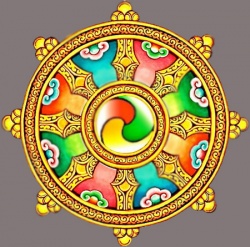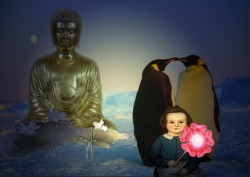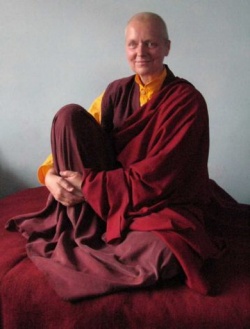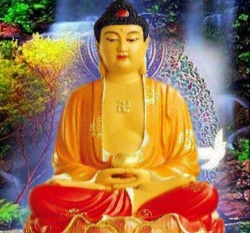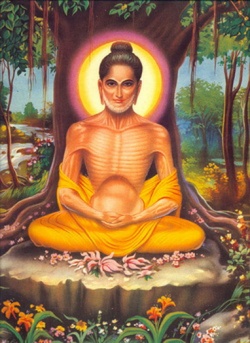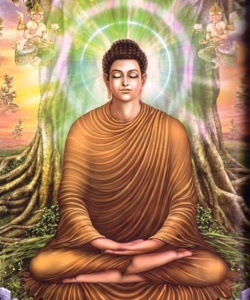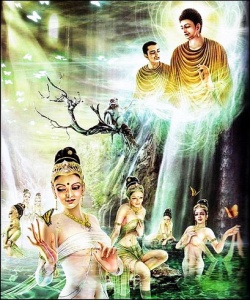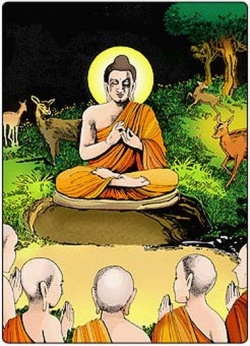Manual of Abhidharma - Reading Seven: Black and White Deeds, the “Path of Action,” and the Root and Branch Non-Virtues
The following selections are taken from Illumination of the Path to Freedom, a commentary to the Abhidharmakosha by Gyalwa Gendun Drup, His Holiness the First Dalai Lama.
Black, White, and Other Deeds Defined
Non-virtue as well as virtue itself taken
In by the form and desire represent
Respectively deeds which are black, white, and both.
The unstained is what brings it to an end.
[IV.237-40]
Just how do we describe these four types of deeds? Non-virtue represents a type of deed which is black and ripens into something black. It is black in that its very nature consists of something afflicted. It also ripens into something black, for it ripens forth into an undesirable result.
Virtue taken in by the realm of form represents a type of deed which is white and also ripens into something white. This is first of all because of its basic nature: it is unmixed with afflicted types of things, within the mental stream in question. And it ripens forth into a desirable result; with the one mental stream, it is not mixed together with any suffering.
Virtue taken in by the realm of desire represents a type of deed which is both white and black, and which also ripens into something both white and black. Since its basic nature is free of affliction it is white but—since within a single mental stream it is also mixed with afflicted things—it is black as well. It ripens into something white because it gives forth a pleasant result but—since within the particular mental stream this is also mixed with suffering—we can also say it ripens into something black.
Deeds which are unstained never ripen into anything either white or black. Their nature is to be what brings “it”—that is, the black kind of deed—to an end.
64
Bringing Black and White Deeds to an End
Twelve types of mental movement had with
Phenomena, mastery, and eight of the
Uninterrupted path free of desire
Are deeds that act to bring the black to an end.
That which is the mental movement in the
Ninth acts to end the white and black.
White by the final uninterrupted arising,
Free of desire for the concentration.
[IV.241-8]
Here is how these deeds are brought to an end. First let’s take the twelve types of mental movement had with the four instants known as “the mastery of phenomena,” as well as eight instants of the uninterrupted path [part of the path of seeing, the direct perception of selflessness) which is free of desire. These are the deeds that act to bring black deeds to an end, for they function to eliminate all the mental afflictions that relate to the desire realm.
Next let’s take that type which is the mental movement in the ninth instant of the uninterrupted path. This is a deed which acts to end the white and black, first of all because it eliminates desire-realm virtue by means of eliminating the aspiration, or the desire, for it. Secondly, it eliminates all the mental afflictions of the desire realm—the process here being that one stops the hold which retains them.
Finally, let’s consider the final instant in the arising of the uninterrupted path which is free of desire for the fourth level of concentration. It is by this that white deeds are brought to an end, for here one eliminates aspiration, that is desire, for virtue of the formless realm.
65
Other Views on the Black and White
According to others, understood as those
For a hell experience, the two for other desire.
Others, what seeing eliminates is black;
White and black, others that come from desire.
[IV.249-52]
According to the claim of certain other groups, deeds which bring one an experience in the hells are to be understood as the “black” ones. And those that bring one an experience in some other birth in the desire realm are to be understood as the two: as deeds that are both white and black. Still other groups assert that those kinds of deeds which the path of seeing eliminates are the black ones, while the other deeds that come from the desire are both white and black. We turn next to our fifth group of deeds, which includes those divided on the basis of the person who possesses them.
72
Three Types of Each Path of Action
The undertakings come from the root three.
Because they occur just subsequent to them,
Coveting and the rest come from these three.
The virtues, with undertaking and conclusion,
From no desire, dislike, ignorance.
[IV.272-6]
Now sutra states that there are three types of killing: that which comes from desiring something, that which comes from disliking something, and that which comes from being ignorant of things. One may ask then whether the various paths of action are each brought to completion by these three roots of all non-virtue.
The answer is that they are not. The statement from sutra was made only with reference to the fact that the “undertaking” stages of deeds such as killing come from the root three.
One may next ask for a description of the process by which the “undertaking” stages of the ten non-virtues come from the three roots of non-virtue. Let’s start with the act of killing. The “undertaking” stage of this type of act comes from desire in a case where, for example, you take the life of another being in order to get its flesh to eat. An instance where this stage comes from dislike would be where you kill your enemy. And a case where the undertaking stage comes from being ignorant of things would be where you kill someone like your father or mother out of some meritorious intent.
Next let’s consider the act of stealing. An example of the “undertaking” stage for this act coming from desire would be where you steal something of value out of a longing for it. A case where this stage comes from dislike would be, for example, where you steal something of value from your enemy. An example of the “undertaking” stage for stealing coming from ignorance is exemplified by the description that “It’s religion when a Brahmin steals.”
Sexual misconduct that comes from desire would be a case where, for example, one engages in some wrong kind of sexual activity because of lustful feelings. Sexual misconduct born from dislike would be represented by engaging in sexual intercourse in order to harm someone else’s reputation. Sexual misconduct that you do from ignorance is typified in the statement that “Sex should be enjoyed by everyone together, like the flowers and the fruits of the earth, like a banquet ready for the feast, like a pool in the river, like a public road.”
Coveting and the rest of the three misdeeds of thought come from these three roots of non-virtue because they occur just subsequent to them—to these three roots. The ten virtues, and here we consider them with all their various stages (undertaking and conclusion, as well as actual commission), come from the states of possessing no desire for something, no dislike for a thing, and no ignorance of things. This brings us to our third point, a detailed discussion of non-virtuous paths of action. We present first the way these paths are committed, the their individual definitions, and finally the literal meaning of the expression “a path of action.”
73
How Non-Virtues are Completed
Taking life, malice, and harsh speech are
Brought to their completion by dislike.
Sexual misconduct, coveting, and
Stealing are brought to completion by desire.
Mistaken views by ignorance of things;
The rest accepted as completed by three.
[IV.277-82]
One may ask just what it is that brings each of the different non-virtues to completion. Three of them—taking life, malice, and harsh speech—are brought to their completion by the emotion of dislike.
Another three—the non-virtues of sexual misconduct, coveting, and stealing—are brought to completion by desire. Mistaken views are brought to completion by an ignorance of things, for mistaken views spring from a deep-seated lack of understanding.
The “rest”—which refers to the three of lying, divisive speech, and meaningless talk—are accepted as being completed by all three poisons of the mind. Such actions motivated by desire, for one example, would be brought to their completion by desire.
74
The Objects of Non-Virtue
The objects consist of living beings, enjoyments.
Names and forms, and then of names as well.
[IV.283-4]
One might ask what things serve as the objects for each of the four divisions of non-virtues just mentioned. The object of the non-virtues of the first division consists of living beings: killing is to take the life of a living being; malice is to feel hatred for a living being; and—as the root text itself says—”harsh speech is that which is unpleasant.”
The non-virtues of the second division have enjoyments as their object: they occur through enjoyment in the form of physical sensations within a living being, or by force of one’s taking possession of certain enjoyments.
The objects of the third division are names and forms, for the non-virtue in this case arises from a view about the virtues and non-virtues that are all part of names and forms in general. The objects of the last division are names, for lying and so forth all occur—ultimately—based on the names of things.
75
Some Ethical Questions
There is no actual stage for those who die
Before or together, for another body’s been born.
Because their goal’s the same in a war or whatever,
All possess it as much as the one who commits it.
[IV.285-8]
“Suppose,” one may begin, “that a person takes a weapon and delivers a blow to someone else which is sure to kill him, but then this murderer himself happens to die, either before his victim or together with him—at the same time. Can we say then that the actual “commission” stage of a full path of action has occurred for such a murderer, or not?”
The answer is that there is no occurrence of this stage for such a person. In the first place, the stage cannot occur before the victim dies; in the second place, where the murderer dies at the same time as his victim, another body of the killer has been born. There is no actual commission because the body never went through the stage of undertaking this act towards the victim in question.
One may raise another question: “Suppose a group of people are engaged in a war or similar activity, and one of these people kills someone from the other side. Does a path of action occur only for the one person who actually did the killing?” It does not. Because they are engaged in the war (or whatever activity it may be) for the same common goal, all the people involved come to possess a full path of action, just as much as the one who commits it.
Next we present the definition of each individual non-virtue. We start with the “root” non-virtues, continue to the “four expressions,” and end with the six “branch” non-virtues.
76
Definitions of the Four
“Root” Non-Virtues
Taking life is killing another being
Purposely, and without a mistake.
Stealing is to take possession of
Another’s wealth by means of force or stealth.
Sexual misconduct, of four types,
Engaging in improper kinds of sex.
Lying’s when the meanings of one’s words
Are understood, a wrong impression given.
[IV.289-96]
“What,” one may ask, “is the basic nature of each of the ten non-virtues?” The taking of life is defined as killing another being purposely, and without a mistake. The word “purposely” is meant to indicate that there is no problem like where the being in question has died but there was no intent.
The words “without a mistake” are meant to indicate that no “actualcommission” stage of an act occurs in a case of mistaken identity; for example, in a case where you undertake to kill John but instead kill Joe because you have mistaken him for John. The word “another,” finally, is meant to indicate that no “actual-commission” stage occurs either in an instance where one takes his own life.
Stealing is to take possession of another’s wealth, purposely and without a mistake, whether it be by means of superior force or by stealth—undetected. Sexual misconduct is engaging in kinds of sex which are improper to perform, purposely and with no mistaken identity.
This sexual misconduct is of four different types, as the number of the following list each constitutes one of its forms:
1) sex with someone else’s wife or with a woman who, although she is not another person’s wife, is too closely related to oneself—his mother, or sister, or any female related to one up to seven generations past;
2) sex with a woman, even if she is one’s wife, using an improper part of her body—her mouth or anus;
3) sex in an improper place—out in the open or in the environs of a shrine or temple; and
4) sex at an improper time—while a baby is still nursing from the woman, or when she is pregnant, or during the period that she is observing the one-day layman’s vow.
Lying is when the meanings of one’s spoken words are understood by the other person involved, and a wrong impression has been given him—purposely, and without any mistaken identity. Next we describe the “four expressions.”
77
The Four Expressions
That experienced by consciousness
Of eye, of ear, the thought, and by the three
Represents respectively what’s seen,
What’s heard, what’s known, and also what is sensed.
[IV.297-300]
Now sutra makes mention of the “eight expressions of a child” [one who has yet to see selflessness directly], which consist of:
1) four types where you say “I didn’t see it” and so on about four different kinds of things—things that you really did see, hear, know, or sense; and
2) four types where you say “I did see it” and so on about another four kinds of things—things that you really didn’t see, hear, know, or sense.
Sutra also mentions the “eight expressions of a realized person”—four where you say “I did see it” about things you really did see and so on; four where you say “I didn’t see it” about things you really didn’t see and such.
Regarding these two sets of eight, one may ask for a more detailed description of the basic four: what it is to be “something seen,” “something heard,” and so on. That which is experienced by consciousness of the eye, consciousness of the ear, consciousness of the thought, and by the other three kinds of consciousness (those of nose, tongue, and body) represents respectively what is seen, what is heard, what is known, and also what is sensed.
We turn next to a description of the six “branch” non-virtues.
78
Six “Branch” Non-Virtues
Divisive speech, the words of a mentally
Afflicted state meant to split up others.
Harsh speech is that which is unpleasant;
Meaningless, really every afflicted.
Others, every other afflicted type like
Flattery for gain, a song, a show.
Like too wrong commentaries. Coveting
Wrong desire for another’s wealth.
Harmful intent, hating a living being;
Mistaken view, the idea that neither virtue
Nor non-virtue even exists.
[IV.301-11a]
Divisive speech consists of words which are spoken purposely, without any mistake, and in a mentally afflicted state; they are meant to split up others who are friends, and their meaning should be understood by the other person. Harsh speech consists of unpleasant words which are spoken purposely, and without any mistake; their meaning too should be understood by the other person.
“Meaningless speech” really refers to every case of words spoken in an afflicted state of mind. Other groups say that what “meaningless speech” actually refers to is every afflicted type of the spoken word other than those three already mentioned. They say cases would be like a monk’s engaging in the improper livelihood of flattering someone for the purpose of some gain, or else singing a song out of desire.
Still other cases would be where the monk told stories to entertain others at a show put on by some performer, or too where he began reciting some wrong commentary written by a non-Buddhist.
Coveting consists of a wrong (that is, an improper) desire for another’s wealth, which leads to a wish that one make it his own. Harmful intent is the desire to hurt another living being, a desire which comes from the attitude of hating him. And mistaken view is the idea that neither virtue nor non-virtue even exists.
Next we discuss the literal meaning of the expression “a path of action.”
79
Explanation of the Expression
In them,
Three are paths, seven deeds as well.
[IV.311b-12]
One may ask why the expression “path of action” is used in reference to “them”—to the group of ten just listed. The name derives first of all from the fact that the three involved with thought are paths by which the “action” or deed of mental movement is expressed. Moreover, the seven involved with body and speech are action or deeds themselves, as well as paths through which mental movement is expressed. Thus they are all “paths of action.”
The fourth major part in our presentation of the “paths of action” concerns the ways in which one loses, and then regains, his most basic virtue.
The following selections are from the Great Book on the Steps of the Path, composed by Je Tsongkapa (1357-1419).
Here is the first. One may ask, “How do you define the act of killing?” The Abbreviation says that five parts are involved: the object, the conception, the thinking, the bad thought, and the conclusion. These five can be shortened into four: the middle three can be included into the thinking, and we can add the stage of undertaking; this makes the presentation easier, and in no way violates the intention of the original text.
Now the object for killing is a sentient being: anything with life. The Levels of Practitioners does state “another living being,” but is only referring to the fact that, when the murderer is murdering himself, there is a wrong deed of undertaking, but not one of completion.
The part of the thinking has three components of its own. Conception can be of four different types: to conceive of the object, say a living being, as being a living being; to conceive of a living being as something other than a living being; to conceive of something other than a living being as being other than a living being, and to conceive of this same thing as a living being. The first and third types of conception here are unmistaken; the second and fourth are mistaken.
This is a particular feature of the motivation. Suppose, for example, that you think to yourself, “I only want to kill John,” and undertake the deed. Then you mistake Joe for John, and kill Joe. In this sort of case, there is no “actualcommission” stage; so we can see that, for this stage, the conception you have must be unmistaken. If on the other hand you undertake the deed with some general kind of motivation, if you think to yourself, “I’ll kill anyone I happen to meet,” then this detail of the conception having to be unmistaken need not be complete. You should understand that this point applies to the other nine as well.
The second component of the thinking is the bad thought involved. In this case, it can be any of the three poisons.
A third component is the motivation; here, it is the wish to kill. Here are the different aspects of the undertaking. As far as the one who undertakes the deed, it doesn’t matter whether you perform it yourself, or get someone else to do it for you, it’s all the same. The essence of the undertaking is when the deed is initiated, either with some kind of weapon, or poison, or spell, or whatever the case may be.
The conclusion occurs when, due to this undertaking of the deed, the other person dies, either at the time of the undertaking, or later on. As the Treasure House of Knowledge says,
There is no actual stage for those who die
Before or together, for another body’s been born.
Three of the ten—killing, harsh words, and harmful intent—can be initiated by any of the three poisons, and are brought to a conclusion by disliking.
Three of them—stealing, sexual misconduct, and coveting—can be initiated by any of the three poisons, but are brought to a conclusion only by desire.
Three more—lying, divisive speech, and meaningless speech—can be initiated and brought to a conclusion by all three.
One of the ten—wrong views—can be initiated by any of the three poisons, but is brought to a conclusion only by dark ignorance.
The movements of the mind are an action (karma) but not a path of action. The seven of body and speech are both an action and—because they are the basis in which the movement of the mind engages—are also a path of action. The three of coveting and so on are a path of action but not themselves action (karma).
See also
- Manual of Abhidharma - Reading One: Introduction to Abhidharma
- Manual of Abhidharma - Reading Two: The Nature of Karma, and What it Produces; the Detailist Concept of ''Non-Communicating Form''
- Manual of Abhidharma - Reading Three: Types of Deeds, and the Nature of Motivation
- Manual of Abhidharma - Reading Four: The Correlation of Deeds and Their Results
- Manual of Abhidharma - Reading Five: How Karma is Carried, According to the Mind- Only School
- Manual of Abhidharma - Reading Six: How Emptiness Allows Karma to Work, According to the Middle-Way School
- Manual of Abhidharma - Reading Seven: Black and White Deeds, the “Path of Action,” and the Root and Branch Non-Virtues
- Manual of Abhidharma - Reading Eight: Most Basic Virtue, and the Projecting and Finishing Energy of Deeds
- Manual of Abhidharma - Reading Nine: The Five Immediate Misdeeds, and the Concept of a Schism
- Manual of Abhidharma - Reading Ten: The Relative Severity of Deeds and What Causes It
- Manual of Abhidharma - Additions Part 1
- Manual of Abhidharma - Additions Part 2
